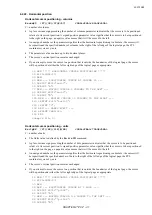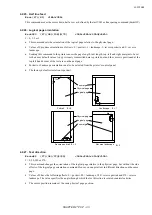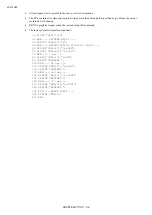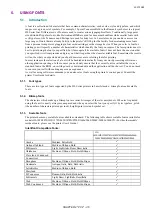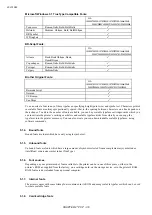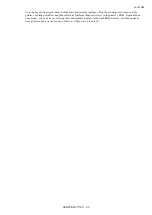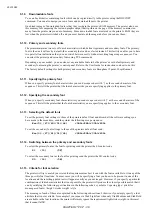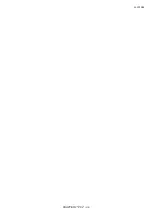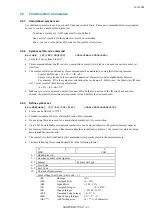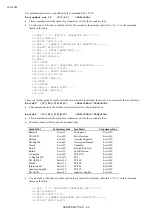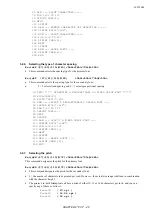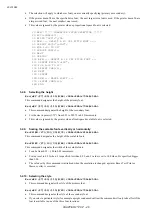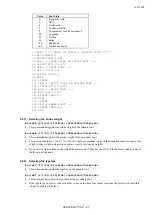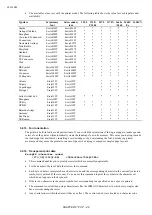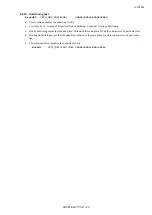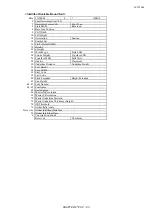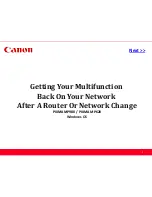
2001/10/02
CHAPTER 2 "PCL" - 40
5.1.16. Symbol set
The symbol set is the list of symbols that constitute a particular font. Normally, symbol sets contain lower and
upper case letters, numbers, punctuation marks and a selection of other commonly used symbols. Some symbol
sets are designed for specific needs, for example, for generating text with mathematical expressions. The symbol
set has the highest priority of all the characteristics you specify when you designate the font you require. If the
symbol set you choose is available, but not in conjunction with any of the other characteristics you specify, the
printer will satisfy your symbol set request at the expense of the rest of your designation and the text printed out
may well look completely different from what you expected to see.
5.1.17. Symbol collections
The symbol collections contain many symbols and a symbol set is made from symbol collections by selecting the
required symbols for unbound fonts. As symbol collections have more symbols than symbol sets, unbound
fonts can have more symbols than bound fonts. Due to the compatibility between symbol sets and symbol
collections, the printer searches the designated MSL or Unicode number by using a symbol set mapping table.
5.1.18. Type of character spacing
Character spacing is either fixed (monospacing), in which every printed character is allocated the same amount of
space on the line, or proportional, where characters are spaced according to their shape and size. For any serious
typographic work proportional spacing is essential since fixed spacing is unattractive and hard to read. In
general, monospacing is used with bitmap fonts and proportional spacing is used with scalable fonts. However,
proportionally spaced bitmap fonts do exist.
5.1.19. Pitch
Pitch is the number of characters that are printed per inch and therefore only applies to monospaced fonts. If you
make a pitch selection while using a proportionally spaced font the command will have no immediate effect.
However, the new pitch will be stored as part of the primary (or secondary) font designation and applied the next
time a monospaced font is selected as the primary (or secondary) font.
The printer’s in-built bitmap fonts all have a pitch of either 10, 12 or 16.66 characters per inch.
5.1.20. Height
Height refers to the height in points (1/72") of unaccented capital letters in a font. This is the generally accepted
method of defining the height of a font’s characters. Scaled fonts can be specified to an accuracy of 0.25 points.
5.1.21. Style
A font’s style is defined by its posture (upright or italic), width (condensed, normal or expanded) and structure
(solid, outline or shadow). Upright and italic bitmap fonts and scalable typefaces are available in the printer’s
ROM. However, these are all normal and solid fonts. To print using any of the other styles (for example, using
Condensed Helsinki or Outline Tennessee) you would have to download the requisite font or install a font
card/cartridge containing it.
5.1.22. Stroke weight
Stroke weight refers to the thickness of the lines which make up the printed characters. Characters of normal line
thickness are called medium. Thicker lines are referred to as bold or black and thinner lines as light or thin. You
can specify 15 different stroke weights - 0 denotes medium weight, negative values signify thinner strokes, and
positive values signify bolder (thicker) strokes. If you have the bold font available that matches your font
designation, a stroke weight selection of 1 to 7 will produce bold text. Likewise, for light or thin text you would
need to make the requisite light or thin font available for the stroke weight selection to have any effect.
5.1.23. Typeface
Typeface refers to the designed style of the characters. Commonly known typefaces include Times, Helvetica,
Univers and Palatino. The printer has its own resident typefaces. When selecting a particular typeface ensure
that it meets all your other specified criteria, otherwise the printer will substitute a font of a different typeface that
can satisfy the other, higher priority criteria, such as style and stroke weight.
Summary of Contents for HL-1250
Page 15: ...2001 10 02 CHAPTER 1 INTRODUCTION 1 CHAPTER 1 INTRODUCTION ...
Page 20: ...2001 10 02 CHAPTER 1 INTRODUCTION 6 ...
Page 21: ...2001 10 02 CHAPTER 2 PCL 1 CHAPTER 2 PCL PRINTER CONTROL LANGUAGE ...
Page 59: ...2001 10 02 CHAPTER 2 PCL 39 ...
Page 76: ...2001 10 02 CHAPTER 2 PCL 56 ...
Page 104: ...2001 10 02 CHAPTER 2 PCL 84 71 71 Lines picture Same as above ...
Page 109: ...2001 10 02 CHAPTER 2 PCL 89 ...
Page 123: ...2001 10 02 CHAPTER 2 PCL 103 ...
Page 131: ...2001 10 02 CHAPTER 3 PCL5C 1 CHAPTER 3 PCL5C ...
Page 149: ...2001 10 02 CHAPTER 4 HP GL 2 1 CHAPTER 4 HP GL 2 GRAPHICS LANGUAGE ...
Page 199: ...2001 10 02 CHAPTER 4 HP GL 2 51 ...
Page 204: ...2001 10 02 CHAPTER 4 HP GL 2 56 ...
Page 205: ...2001 10 02 CHAPTER 5 PJL 1 CHAPTER 5 PJL PRINTER JOB LANGUAGE ...
Page 248: ...2001 10 02 CHAPTER 5 PJL 44 ...
Page 263: ...2001 10 02 CHAPTER 5 PJL 59 ...
Page 264: ...2001 10 02 CHAPTER 6 EPSON 1 CHAPTER 6 EPSON FX 850 ...
Page 286: ...2001 10 02 CHAPTER 6 EPSON 23 LPRINT CHR 27 CHR 37 CHR 1 CHR 0 Select downloaded characters ...
Page 290: ...2001 10 02 CHAPTER 6 EPSON 27 Sample 12 ...
Page 292: ...2001 10 02 CHAPTER 6 EPSON 29 Sample 14 ...
Page 294: ...2001 10 02 CHAPTER 7 IBM PROPRINTER 1 CHAPTER 7 IBM PROPRINTER XL ...
Page 315: ...2001 10 02 CHAPTER 7 IBM PROPRINTER 22 ...
Page 316: ...2001 10 02 CHAPTER 8 BAR CODE CONTROL 1 CHAPTER 8 BAR CODE CONTROL ...
Page 326: ...2001 10 02 CHAPTER 9 HP GL 1 CHAPTER 9 HP GL GRAPHICS LANGUAGE ...
Page 353: ...10 5 2001 APPENDIX A COMPARISON LIST 1 APPENDIX A COMPARISON LIST ...
Page 391: ...10 5 2001 APPENDIX A COMPARISON LIST 39 AUTOSKIP ON OFF ON OFF ON OFF ON OFF ...






